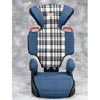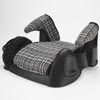 |
 |
 |
|
|
The Best Booster Seat The question child passenger safety experts hear the most is "What is the best seat?" The answer isn't a specific
brand or model, but this: The best seat is the one that fits your child, fits your car, and that you will use correctly
every time. How do you find that one? By knowing what you're looking for. The following guidelines can help you find that
BEST seat for you. A booster seat is used to lift up a child and properly
position the vehicle's lap/shoulder belts on children who are too small to
fit the adult seat belt. Boosters are rated for
use from 30-40 lbs to 80-100 lbs. Booster seats do not have a harness.
FITS YOUR CHILD Many booster seats have a minimum weight of 30-33 lbs. However, a
booster seat should not be the next purchase when the
child outgrows a convertible seat. A child is safest if
they remain in a harnessed seat until they reach at least 40 lbs. A
combination seat should be used after the
child has grown too tall for a forward-facing convertible, but is not yet
heavy enough (40 lbs) to move into a booster. It is also important to take the temperament and maturity level of your child into consideration. To sit in a booster seat, the child must be capable of sitting up without slouching or leaning over, keeping the belts in place, and staying buckled. If your child is unable to do so (whether because of age, maturity or personality), a higher weight restraint should be considered as the next step. I strongly recommend that you take your child with you when shopping for a booster seat. Sitting the child in the seat will give you an idea of how it fits now and will fit several years down the road, how comfortable it is, and whether your child likes it. Here are some features to look for when searching for a seat that will fit your child: Belt fit A booster seat is designed to properly position the lap and shoulder belt on a child. Try the seats out in your vehicle. The lap belt should fit snug across the upper thighs and not ride up onto the tummy. The shoulder belt should comfortably cross the child's shoulder and not fall off onto the arm or cross the neck. Most boosters offer some type of "arm" that helps keep the lap belt low. The shoulder belt guides should help keep the shoulder belt in position. Length and width The child's legs should hang comfortably at the edge of the booster seat without the child having to slouch. The child's hips should fit comfortably between the sides without being squished or having too much "play". Some booster seats offer an adjustable width (Britax StarRiser) to help accommodate growing children. Be sure that the booster seat length and width fits the child comfortably now. A shorter booster seat may need to be replaced later on if the knees are hanging off the end, making the thighs uncomfortable. Padding A seat with minimal padding will make the child uncomfortable and cranky on longer trips. Some seats have the padding in the cover, others have padding underneath. Don't hesitate to take the seat apart and check out the underneath parts to be sure your child's body will be well-supported. Seat height If you choose to use a high-back booster, be sure you note how high the back is. For the growing child, the higher the seat back, the longer they'll fit. The seat back is outgrown when the tops of the child's ears are even with the top of the seat. High back or backless Which type of booster you get depends mostly on your vehicle. If your vehicle has low seat backs or does not have any head restraints, you will need a high back booster to provide whiplash protection for your child. If your vehicle does have head support, a backless booster is fine. However, some younger children prefer a high back style, as the side "wings" allow for more sleep support. Also, some older children prefer a backless style that does not "show" as much and cause teasing from peers. You must be absolutely sure that your child has adequate head support before using a backless style. Remember, safety before popularity. FITS YOUR VEHICLE Many people are not aware that not every seat fits
every car. Try before you buy! Places like Toys R Us, Babies R Us and many
baby specialty stores will allow you leave a drivers license or other ID
and take floor models out to your vehicle to check the fit. Here are some
features to check when trying a booster in your vehicle: Base fit The base size and design varies from booster to booster. Since the booster will not be held in with any belts, it is important that it fit well on the vehicle seat. Choose a booster that fits within the vehicle seat contours and does not easily tip over or slide around. High back or backless Which type of booster you get depends mostly on your vehicle. The top of the child's ears should not go over the top of the vehicle seat or head restraint. If the child is too tall, you will need to purchase a high back booster to provide head support and whiplash protection. If the child has adequate head support in the vehicle, a backless model is fine. USE CORRECTLY EVERY TIME This is
the biggest issue, especially considering that somewhere between 85-95% of
ALL car seats are misused. There are many user-friendly features on seats
that will enable you to use it correctly with less effort, but you have to
look for them. Used seats Make sure the safety seat is less than 10 years old (preferably less than six) and has never been used in a crash, even a minor fender-bender. You can't be sure about the history of a used safety seat unless you got it from a friend or relative. You will need the detailed instruction booklet which can be ordered from the manufacturer if it is missing, to check that the safety seat has all of its parts and to find out how to use it correctly. Check for possible damage, such as cracks in the plastic, dents, and missing parts. You can follow the USED SEAT CHECKLIST to determine whether your used seat is still safe. Backless shoulder belt adjusters The shoulder belt adjuster on backless models helps to pull the shoulder belt into the correct position; usually by means of a plastic clip and fabric cord. Some of these models are very easy to adjust, others can be time consuming and break easily. Be sure to choose a model that you will be able to adjust properly for a good fit on every ride. If the shoulder belt does not fit correctly, the child may be tempted to put it behind their back, which puts them at great risk for injury. Open Belt Guides There are several different types of "guides" that position the shoulder belt on high back boosters. Some of these guides can allow the child to lean forward and introduce slack into the shoulder portion of the belt, but when they lean back, the belt cannot retract. This can put the child at risk, as the upper body protection has been compromised. Try the seat out in your vehicle and be sure that the shoulder portion of the belt can move freely through the belt guide. EXTRA FEATURES Although every seat is designed to meet the current
Federal Motor Vehicle Safety Standard, not every seat is the same. Some
manufacturers add design features or safety features that make the seat
easier and safer to use. Here are a few: EPS Foam EPS stands for Expanded PolyStyrene and this impact absorbing foam is similar to what you find in bicycle helmets. It protects the head from injury. This has been standard on European seats for years, but only a few American seats have it. It is definitely preferable to a seat in which your child's head strikes hard plastic. Recline For younger children that still sleep in the car, a booster seat can sit very upright. Several high back versions allow the booster back to match the vehicle seat slope, providing a more comfortable ride for younger kids. Accessories None of the "extra" accessories offered on booster seats are really necessary, but may be useful or attractive to your children. Some of the accessories include cup holders, toy nets, head pillows and snack cups. A Certified Child Passenger Safety Technician This doesn't actually come with the seat. You'll have to go out and find one in your area. Since the misuse rate is about 95% and most parents don't realize that they fall under that misuse rate, it is very important to have a certified child passenger safety expert teach you how to safely use your seat. Note that a recent survey found that 96% of parents thought they were using their seats correctly and 90% of them were wrong! Motor vehicle crashes are the LEADING cause of death to children under 15, and being in a properly used seat reduces the risk by 71% for infants in the rear-facing position and 54% for toddlers in the forward-facing position. The safer your child is, the better chance they have at surviving a crash, and that's why you're getting the seat in the first place anyway! Let a certified technician teach you how to PROPERLY use your seat. Finally, don't hesitate to ask for help. There are a lot of seats out there and it can be confusing. We welcome e-mails from people who are searching for a seat. Please note: due to the large volume of e-mail we receive, it may take 1-2 weeks for us to reply. If you have a pressing question, we highly recommend you visit the car seat board where many knowledgeable certified technicians are happy to answer your car seat questions. Good luck! and happy shopping. |
Copyright
© CPSafety
All Rights Reserved


